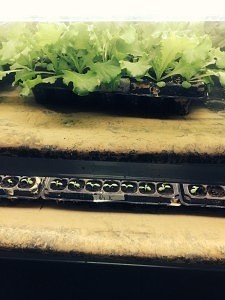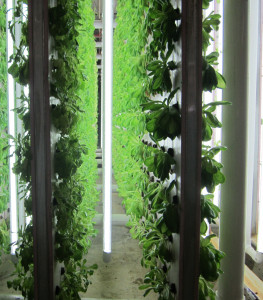An Introduction to Hydroponics – Healthy for Your Body and Good for the Planet
What is hydroponics? Hydroponics is a system that allows plants to be grown indoors, without soil, in a nutrient rich environment. While this may seem oddly against Mother Nature, the process and result can be incredibly beneficial to both your body and the earth.
Imagine a nondescript inner city building surrounded by old manufacturing facilities and a desolate parking lot. Now picture yourself walking in the door of this building. Rather than finding the tired emptiness expected from the exterior, you are surrounded by floor-to-ceiling, brilliantly lit herbs and leafy greens. Welcome to urban hydroponics and the fantastic array of good deeds it offers.
If you are like many who live in a frozen tundra during the winter months, you will be very pleased to know that perfectly ripened, fresh herbs and greens can be harvested and added to your happy-body salad in the same afternoon. When food is grown around the corner, there is no delay from harvest to table and there is no carbon footprint.
Hydroponic methods do not use pesticides or herbicides, allowing for clean eating and that welcome smile of gratitude from your body. Because of the widespread use of pesticides and herbicides, cross contamination in traditional farming has become a sad reality and something that our lovely organic farmers work hard to control. Hydroponics are grown indoors. Therefore, the cross contamination concern is eliminated.
I had the opportunity to sit down with an expert in the field and President of Garden Fresh Farms, Peter Cordell, to discuss his hydroponics techniques and to learn from his wealth of knowledge.
Do you recall your inner city urban vision? Peter and his business partner, Dave Roeser, have created exactly that reality. Their hydroponic system headquartered in St. Paul Minnesota is an award winning program of ingenuity and hard work.
To give you a better idea of just how this process works, let’s begin with the seed. In the Garden Fresh Farms model, non-GMO seeds are sprouted during what Peter calls the “kindergarten” stage in a traditional bunk bed method.
After graduation, the seedlings are placed in tall vertical boards hung from the ceiling and rotated through a 35 day cycle (That’s fast! Want to know why? Nutrients! Stay tuned). Stemmed plants are placed in a rotating barrel to keep them on the straight and narrow. (Much like the plant version of your mom telling you to sit up straight.)
Now what about those nutrients? Depending on the system and producer, hydroponics may use many different types of nutrient methods. In our example, Peter found that using a clean closed water loop system that involves hundreds of tilapia, fed high quality nutrient rich fish food, is a recipe for both optimal flavor and integrity. His process uses 95% less water than traditional irrigation. A multi-step conversion process ultimately adds nitrogen to the water that hydrates the plant roots, resulting in a highly nutritious and excellent tasting greens.
Now that your visions are inspired, picture a well fed world with the perfect combination of outdoor organic farming and healthy hydroponics.
Intrigued? Do your research. With some well-placed lights and a lot of knowledge, you too may start your own urban farm.




